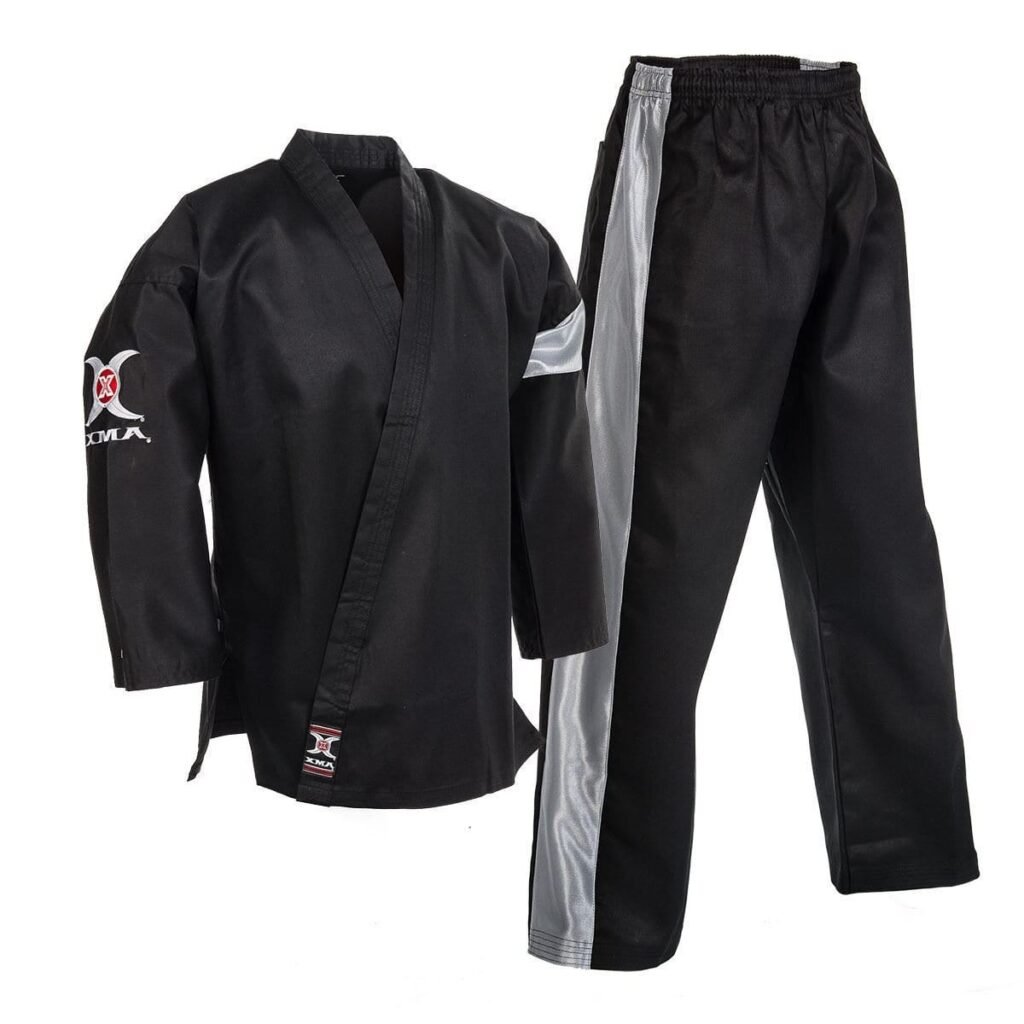
Karate, a martial art with origins in the Ryukyu Kingdom, has grown into an internationally practiced discipline focused on striking techniques and building both physical and mental strength. Today, hundreds of karate styles exist, all requiring a variety of specialized uniforms and equipment to aid training. As Bruce Lee famously said:
“The clothes make the man. Naked people have little or no influence on society.”
This remains true even in the dojo. Investing in proper karate uniforms and equipment ensures maximum safety, flexibility, and ultimately, progress along the path.
Contents
A Brief History of the Karategi
The origins of karate uniforms can be traced back to Okinawa, the birthplace of modern karate. Traditional training was originally conducted in everyday clothes. The karategi, or karate uniform, was later adapted from judo’s judogi design to add durability for karate’s rigorous physical training.
Standardization came in the early 20th century as karate masters began opening public schools to teach the masses. The first karate gi was comprised of a white jacket and trousers, representing purity and equality between students. Different colored belts were later integrated to signify rank.
Today, most styles of karate utilize a basic white uniform and colored belt system for tradition. However, variety exists depending on specific needs. Uniforms are now designed to aid optimal movement, airflow, and moisture wicking for intense training sessions.
Key Components of the Karategi
The basic karategi is made up of a jacket, pants, and belt:
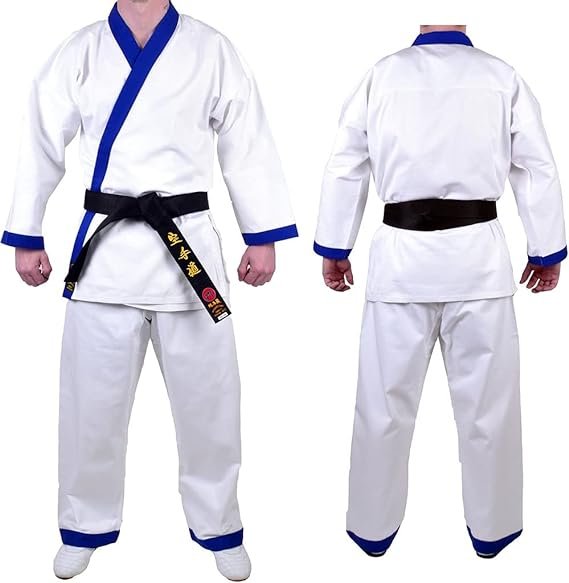
- Jacket – Also called the top or uwagi. Features embroidered logos, short sleeves, and reenforced stitching on the lapel, armpits, and shoulder seams for durability.
- Pants – Also called zubon. Drawstring waist ties secure a comfortable fit. May have elastic or pleat detailing on lower legs to allow ease of motion.
- Belt – Denotes rank. Long enough to wrap twice around the waist and tie securely. High ranking dan levels may have embroidery details.
While simple in components, many factors alter the style, weight, quality and price point of karategi for both practice and competition purposes.
Types of Karategi
Many variables differentiate the array of karate jacket and pants combinations. Considerations include martial arts discipline, cut and fabric, weight class, and gender to determine appropriate uniforms.
Martial Arts Variation
Though specifications may vary between organizations, below represents the common uniforms used in major karate styles:
| Style | Uniform Style |
|---|---|
| Shotokan | Lightweight gi with little to no embroidery |
| Goju-Ryu | Thicker traditional cut uniform |
| Kyokushin | Tighter fighting gi often with short sleeves |
| Shitō-ryū | Middleweight gi that allows free movement |
Here’s a more in-depth overview of popular karate styles.
Cut and Fabric
Karategi come in two general cuts – traditional and modern athletic fit. Traditional gis allow more airflow with a looser silhouette. Athletic cut uniforms contour tighter to the body for uninhibited motion.
Popular fabrics include cotton, canvas, polyester, and blends:
- Cotton – Most common traditional fabric with some stretch. Breathable and softens over time.
- Canvas – Cotton/poly-blend drill fabric. Very durable and maintains structure well.
- Polyester – Wicks moisture faster. Provide compression. Less need to break-in.
- Blends – Mix fabrics to balance breathability, structure and fast-drying properties.
Weight
The cut and fabric affects the weight and intended purpose:
- Lightweight Gis – 8-10 oz. Used for point sparring tournaments. Emphasize speed and agility.
- Midweight Gis – 10-12 oz. Offer balanced protection and movement for general training.
- Heavyweight Gis – 12+ oz. Thicker stitches and canvas fabric reduce impact during intense kumite sessions.
Heavier gis also work well for strength building by adding resistance to techniques, though they compromise air flow.
Gender Variations
Many brands now offer uniforms with a gender-specific cut to tailor the jacket and pants to anatomically fit female frames. Differences include:
- Curved hip seams on the jacket
- Adjusted sleeve length and shoulder width
- Contoured pants for wider hip to waist ratio
- Generally accommodates shorter average heights
Properly fitted karategi should provide full range of movement without restriction or excess fabric impeding technique. Use brand size charts and measuring tapes to find ideal size. Expect some break-in period as heavyweight cotton gis conform to the body over months of use.
Here’s a helpful karate gi size conversion chart across common brands.
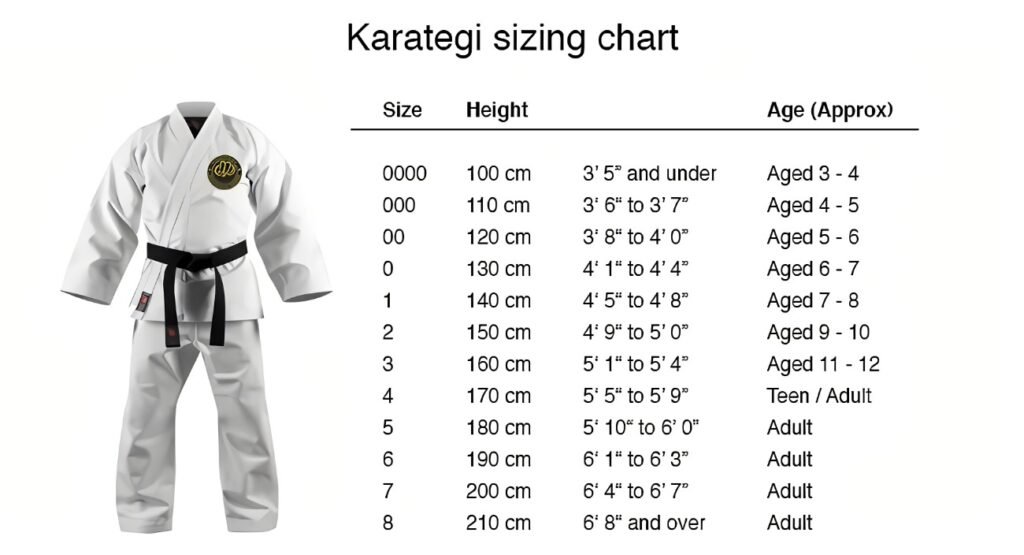
Other Uniform Pieces
The jacket and pants make up the core karategi, though other garments get added for comfort, style or competitive regulations:
Undergarments
Moisture wicking base layers keep students comfortable and focused during sweat-inducing sessions:
- Compression/Rashguard Shirts – Skin tight shirts made of spandex blends. Protect against abrasion and showcase club logos.
- Supporters – Prevent groin injury during kicks and grappling. Must fit securely under gi pants.
Supporters necessary for all male students. Female chest and hip protective equipment optional.
Outer Layers
Additional uniform pieces for before/after practice include:
- Jackets – Water resistant nylon windbreakers. Fleece linings for warmth. Display club patch and sponsorship logos.
- Pants – Matching sweatpants for warming up/cooling down. Chambered cuffs prevent dragging.
- Hoodies – Casual zip-up hoodies for comfort and pride in the dojo.
Clubs often require students purchase these co-branded pieces to generate revenue for operations and tournaments.
Headwear
Headbands, caps, and bandanas manage sweat and keep hair secured:
- Sweatbands – Absorbent terrycloth strips tied around forehandpreferred for intense sparring.
- Caps – Baseball caps with karate logos. catastrophe side rotate
- Bandanas – Traditional hachimakis tied behind head containing insignia.
Extra uniform pieces allow students train without distraction while showcasing discipline.
Essential Karate Gear & Training Equipment
Beyond the garb, dedicated gear helps hone skills safely and efficiently. Equipment falls into key categories:

Karate practitioners concur investing in your own equipment prevents transmission of bacteria or fungi from micro tears to skin or callouses. Sharing unsterilized gear can lead to dangerous infections like MRSA.
Below highlights essential karate aids per type:
Striking Gear
Target pads and shields allow students to thrust full forced blows without injuring partners. Key examples include:
- Focus Mitts – Padded gloves instructors wear to hone combination hand strikes. Easy to angle returning power shots.
- Kick Shields – Long rectangular pads with convenient handles focus building leg muscles hitting roundhouses. Larger body shields teach covering distance.
- Reaction/Reflex Bags – Dangling rubber balls suspended from cords improve precision striking moving targets.
Meanwhile punching gear protects students’ hands and limbs from overexertion stressing joints and ligaments:
- Gloves – Foam or leather bag gloves stabilize wrists preventing sprains and fractures to fragile bone networks.
- Hand Wraps – Gauze strips support weak knuckles prone to breaks, especially for heavy bag drills.
- Punching Mitts – Padded foam mittens teach hooks, uppercuts and ensure proper fist rotation.
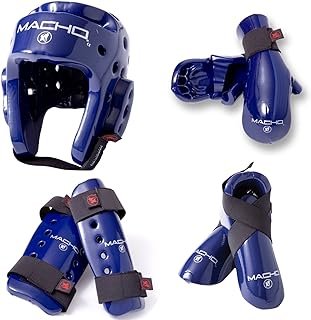
For leg conditioning, foam or plastic padding slips over shins and insteps absorbing friction trauma from repetitive kicking:
- Foot Pads – Protect vulnerable metatarsals and toes inside shoes/sandals from fractures and dislocations.
- Instep Guards – Shield delicate ankle tendons from snapping back with the whipping force of roundhouses and side kicks.
These striking accessories become necessities when elevating intensity towards black belt training.
Sparring Gear
Once basics get established, controlled full contact sparring allows practical skill application. Mandatory protection equipment keeps these sessions injury-free learning experiences.
Standard sparring gear includes:
- Headgear – Face cages deflect incoming blows targeting the temples, nose and jaw region.
- Mouthguards – Prevent cracked teeth and lip lacerations. Fit top and bottom rows of teeth.
- Gloves – Padded knuckles reduce chances of cuts and bruises during stand up exchanges.
- Chest Protectors – Foam vests protecting sternum and ribs from body blows. Snug fit imperative.
- Shin Guards – Hard shields covering shins absorb roundhouses. Anchor securely with velcro straps around calves. Avoid soccer style guards.
Referees inspect all equipment before matches evaluating condition and compatibility between opponents based on age, rank and weight differentials.
Investing in your own sparring kit allows consistent training without risk of contamination from other’s sweat. Make sure properly sized gear doesn’t impede motion while standing or kicking.
Training Aids
Supplementary workout tools engage smaller supporting muscles neglected from strict striking practice:
- Resistance Bands – Stretchy rubber loops or flat bands add load to basic movements improving strength.
- Foam Rollers – High density tubes massaging muscles pre/post workout increase flexibility and circulation.
- Balance Trainers – Bosu balls improving proprioception protecting joints from torque pressures.
- Agility Ladders – Footwork grids developing explosiveness essential for combinations.
Incorporating these affordable fitness aids enhances performance elements not directly trained holding focus mitts or kicking pads. Diversify training!
Punching Bags
Heavy bags develop devastating power translating technique into impact force. They come in various forms:
- Free Standing – Self containing vertical bags allow angle variability developing kicks. More expensive than hanging versions.
- Hanging – Traditional horizontal bags suspended from ceiling beams or stands. Accessible for all gyms.
- Wavemaster – Bottom heavy base supporting flexible pillar minimizing risk of swinging back if missed strike. Ideal for beginners.
- Kickboxing Trainers – Long columns padded at multiple heights for practicing angle kicks up and down entire leg.
Work heavy bags bareknuckle to toughen skin and bone. Add weight as larger bags minimize oscillations from absorbed strikes.
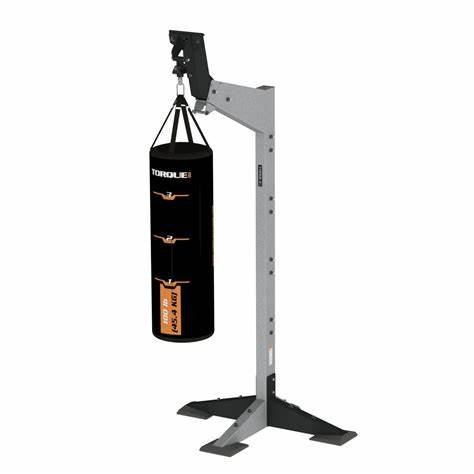
Warning: Broken fists from improperly taped hands or misaligned strikes remain unfortunately common. Treat punching equipment with patience and care.
Martial Arts Weaponry
Though banned from competition, karate styles descending from Okinawan heritage still teach coordination drills using traditional tools:
- Bo Staff – Long wooden poles improve agility handling additional length.
- Sai – Three pronged daggers flowing from open hand movements.
- Nunchucks – Two sticks linked by a short rope or chain develops complex patterns.
- Kama – Small scythe blades mimicking inside knife hand blocks.
- Tonfa – Side handle batons representing ulna bone in blocking.
Weapons training hones reflexive speed and eye tracking multiple opponents. Have an instructor closely supervise initial drills given unpredictable rebounding trajectories.
The Purpose and Proper Care of Karate Uniforms
Beyond correct sizing and tailoring, understand the intended functionality behind karate uniforms and gear:
Purpose
- Prevent injury – Durable fabrics and protective padding shield students from harm.
- Maximize movement – Unrestrictive cuts, stretch fabrics, and lightweight materials avoid impeding motion.
- Manage moisture and temperature – Sweat wicking and breathable materials keep body cool, dry and comfortable for peak performance.
- Strengthen mind-muscle connection – Snug fight shorts with bare feet promote balance and grounded force.
- Signify progress – White belts transitioning towards black over years represent time and skill level through color grading.
Care Instructions
- Review fabric composition to determine ideal cleaning method. Most 100% cotton gis withstand hot water washer cycles.
- Pre-treat salt stains from dried sweat using stain removers or vinegar to avoid permanency over time.
- Air dry over heat drying to prevent premature shrinkage compromising later wearability.
- Disinfect regularly using antimicrobial sprays containing bacteria/fungus killing ingredients between uses.
- Repair minor tears immediately before expanding bigger requiring full patch jobs. Carry small sewing kits.
- Store properly between sessions by hanging inside garment bags or folded atop shelf to minimize wrinkling.
As an extension of self, care for karate uniforms properly and inspect for replacement indicators including:
- Faded collar tips and belt ends from years of abrasion against skin and friction against the floor.
- Scuffed embroidered logos and badges from equipment contact during sparring sessions.
- Thin knee and elbow sections prone to tearing from repetitive graning, takedowns and groundwork.
- Shrunken sleeves preventing full extension while punching or blocking.
Plan budgets for replacing warn gear components after committed tenures in the dojo. Prioritize items closest to skin first for sanitary reasons.
Where To Shop for Karate Equipment
Finding authentic karate uniforms and gear takes proper sourcing:
Local Specialty Retailers
- Independently owned martial arts equipment stores.
- Test construction quality and fabric density firsthand.
- Support community business.
Big Box Sporting Good Chains
- Mass retailers like Dicks Sporting Goods or Academy Sports.
- Limited selection but check for sales.
- Try on multiple sizes for best fit.
Official Brand Websites
- Companies like Fuji Sports, Adidas, and Century directly sell specialized product lines.
- Custom embroidery and belt dying services.
- Bulk team order discounts.
Online Comparative Shopping
- Aggregators like Amazon compile options in one place.
- Saves driving to various retailers.
- Be wary of counterfeit products with incorrect specs marketed for lower price points. These offer substandard protection.
When evaluating gear, examine the:
- Fabric density, panel dimensions, and hardware frames against skin. Avoid uncomfortable chafing or pinching.
- Stitching and seam reinforcement holding pieces together. Must withstand years of stretching in multiple directions.
- Overall craftsmanship from an experienced martial arts equipment manufacturer.
While price often reflects quality, remain prudent to balance budgets especially while growing into adult sizes. Start with midgrade gear then upgrade heirloom pieces over milestone achievements like black belt promotions.
Conclusion
Karate uniforms and accompanying gear ensure students train safely to the best of their continually developing abilities. Proper outfits won’t inherently make better martial artists. However, having proper equipment eliminates potential distractions from focusing on perfect technique.
Key takeaways include:
- Traditional karategi jackets and pants now manufactured using modernized materials and athletic cuts tailored to individual bodies.
- Many accessory items from protective innerwear to training bags enhance skills.
- Use appropriate weight and durability factors matching discipline and practice intensity.
- Care for uniforms properly to maximize lifespan through consistent washing, mending, and storage methods.
- Subscribe to club philosophies committing to their styles and supply vendors accordingly.
As Mr. Miyagi famously said:
“Karate come from inside you. Always right inside you. Here [points to heart and then head]. Not here [points at uniform]. Understand?”
Keep this wisdom, as well as this guide’s advice when selecting your training uniforms and equipment. With the proper foundation supporting persistent practice, the fruits of karate will blossom.
OUS!
Here are 30 top FAQs for this karate uniforms and equipment:
What is the karategi?
The karategi is the jacket and pants making the karate uniform.
What are the components of the basic karate uniform?
The basic components are the jacket, pants, and belt.
What does the color of the karate belt signify?
The color of the karate belt signifies the rank or skill level of the student.
What are the most common karate uniform fabrics?
The most common karate uniform fabrics include cotton, canvas, polyester, and poly/cotton blends.
What are the main differences between a traditional and athletic cut gi?
Traditional gis have a baggier silhouette while athletic cut gis contour tighter to the body.
What weight gi is best for sparring?
Lightweight 8-10 oz gis allow maximum speed and movement for sparring.
Why should women consider a female-cut gi?
A female-cut gi adjusts elements like sleeve length, shoulder width, and hip ratios to fit anatomically correct.
What undergarment shirts are recommended wearing under the gi jacket?
Compression rashguard shirts or supportive tank tops work well to manage moisture under the jacket.
What specific gear protects groin, shins, and insteps during karate kicks?
Groin supporters, shin guards, and foam foot pads protect vulnerable body parts from strikes.
What are the mandatory pieces of sparring gear needed for competition kumite matches?
Mandatory competition sparring gear includes headgear, gloves, mouthguards, chest protectors, and shin guards.
Why should students invest in their own sparring gear instead of sharing equipment?
Sharing unsterilized sparring gear risks transmitting bacteria, fungi, and microbial infections from skin contact.
How can resistance bands supplement karate training?
Resistance bands add load to basic movements and engage smaller muscles neglected by repetitive striking alone.
What heavy bag builds kicking coordination best for beginners?
Wavemaster free standing heavy bags with a flexible top minimize risk of recoil from inaccurate strikes.
What traditional Okinawan weapon is similar to the ulna arm bone when blocking attacks?
The tonfa baton with its perpendicular side handle mimics motions like the ulna bone checking kicks and blows.
How are karate uniforms intended to maximize movement?
Lightweight breathable fabrics, unrestrictive cuts, and stretch materials avoid impeding karate motions.
How should karate uniforms be cleaned and dried?
100% cotton gis can handle hot water washer cycles. Air drying avoids premature shrinkage over heat drying methods.
Why should worn uniforms eventually get replaced instead of perpetually mended?
Replacing worn uniforms prevents restricted mobility from faded, torn or shrunken sections.
Where can karate students buy authentic uniforms and equipment locally?
Local independently owned martial arts specialty stores often provide the most authentic gear.
What are signs of high quality karate gear worth investing extra money into initially?
Signs of high quality gear include durable stitching, reinforced stress points, and breathable fabrics closely inspected.
Is buying cheaper karate gear online worth the risk of defects?
Cheaper karate gear risks defects compromising safety. Inspect items closely and buy from reputable established retailers.
What should students prioritize buying first – the full uniform or accessory gear?
Generally prioritize buying the full uniform over supplementary gear first. Upgrade accessories like bags and technology later.
Why must broken hands remain common injuries despite proper punching techniques?
Broken hands happen from misaligned strikes or lack of proper taping supporting fragile wrist bones and knuckles. Treat gear carefully.
What risks emerge when sharing unsterilized equipment in the dojo?
Sharing unsterilized gear risks transmitting dangerous skin infections like antibiotic resistant MRSA between students.
How can students balance managing gear costs with desired quality levels?
Compare prices across retailers during sales to find affordable mid-grade gear, then upgrade heirloom pieces slowly over time.
Why must bo staff training remain closely supervised initially?
Bo staff training with unpredictable rebounding weapons must be closely supervised to minimize injury.
How should clothing logos get repaired as uniforms experience wear?
Scuffed embroidered logos should get patched early before worsening and compromising integrity.
Where should students store gear between karate sessions?
Neatly hang uniforms inside garment bags or fold onto shelves to prevent wrinkling or losing parts.
How can sweat stains get pretreated before washing gis?
Pretreat salt stained gis with stain removers or vinegar before washing to avoid permanency.
Why should MMA gloves differ from traditional karate sparring gloves?
MMA gloves allow grappling while karate gloves offer more fist protection since takedowns get prohibited.
